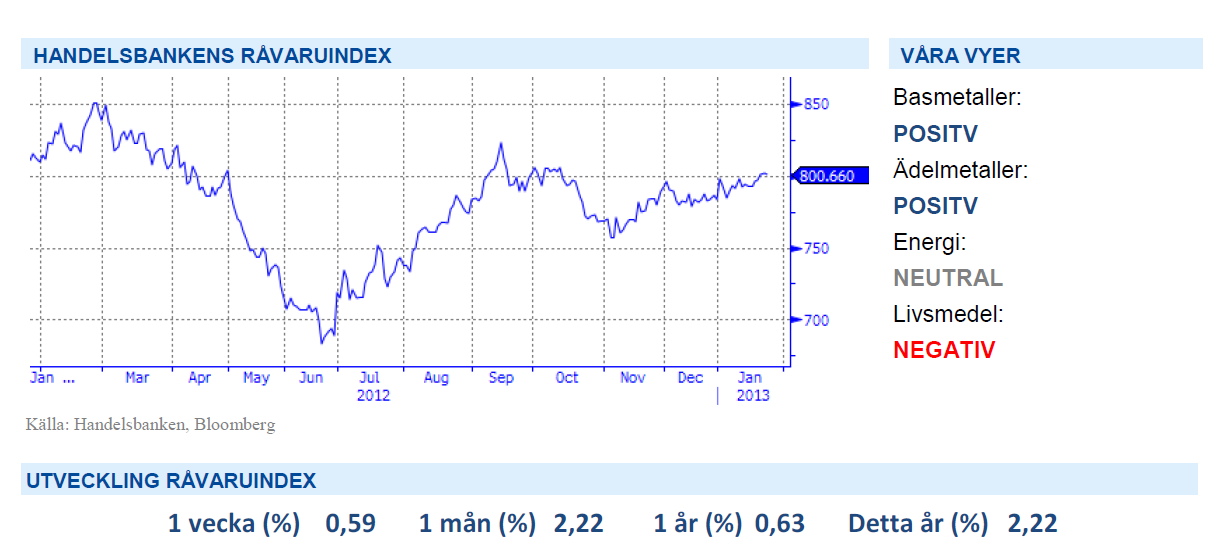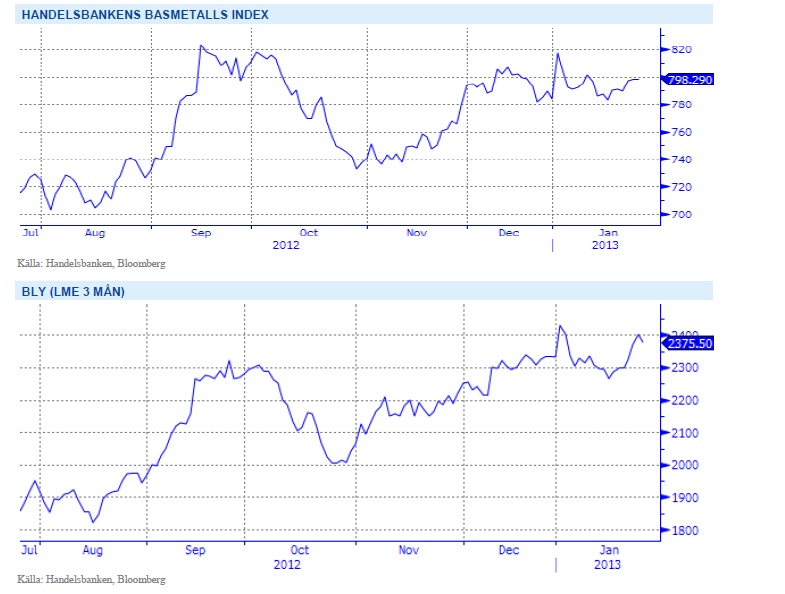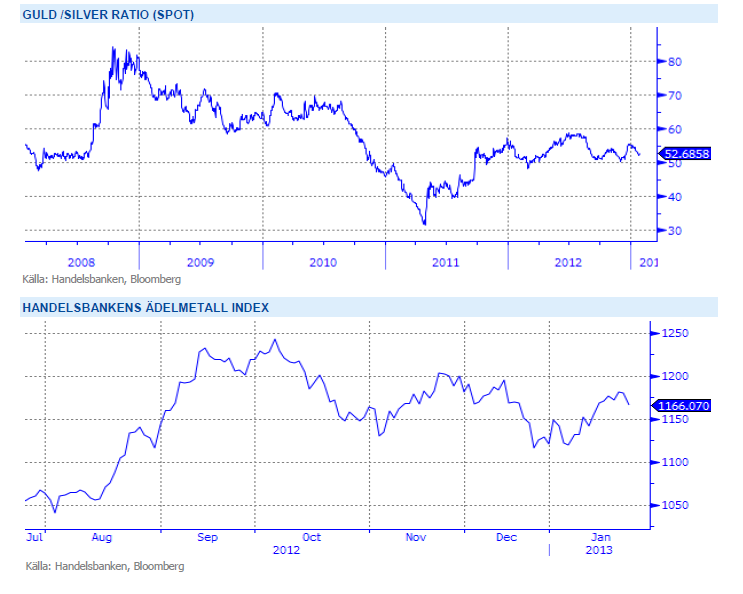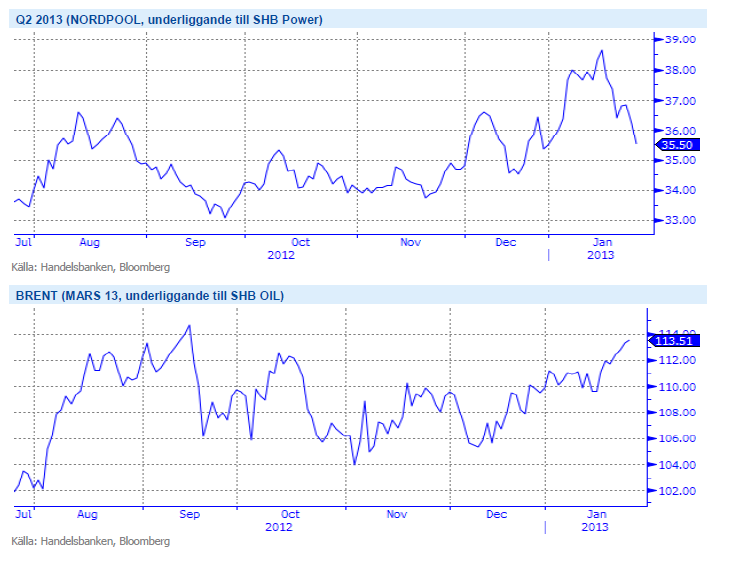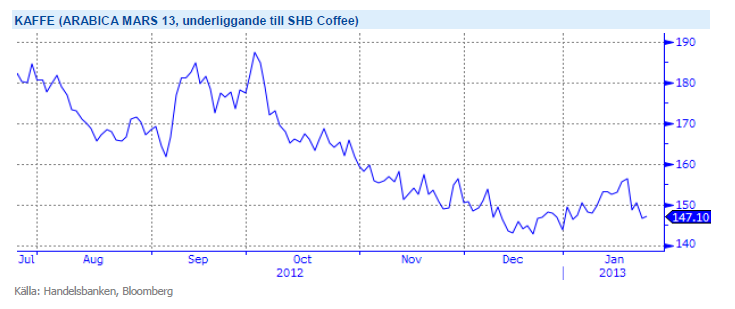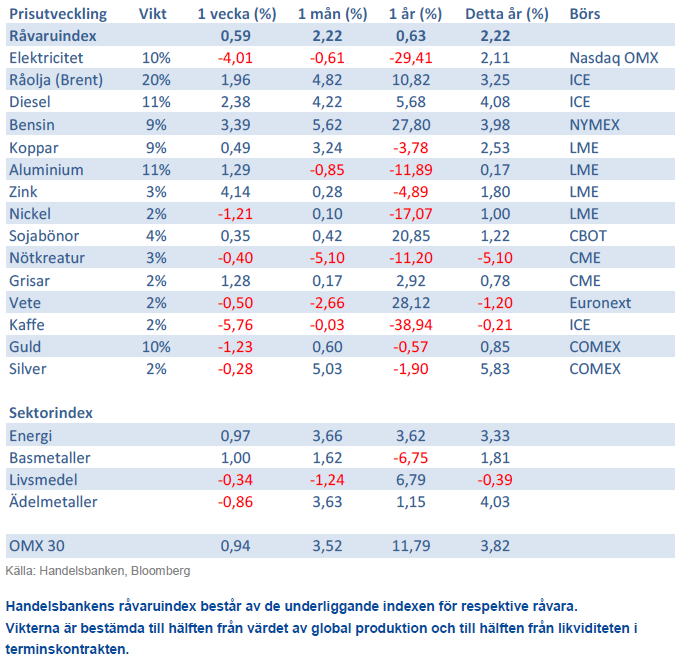Analys
SHB Råvarubrevet 25 januari 2013
 Nyårsrallyt har planat ut
Nyårsrallyt har planat ut
Senaste veckan har inte givit mycket nytt. Rallyt som inledde året har kommit av sig. Många råvaror har fastnat mellan en allt ljusare framtidsbild med starkare global konjunktur och en allt stabilare produktionssida. Det gäller såväl råolja som basmetaller. Valet i Israel gav inte ”Beni” Netanyahu den jordskredsseger han tänkt och nu behöver hans högerparti bilda koalitionsregering. Att israelisk politik kommer söka sig mot mitten är på marginalen negativt för brentpriset som har en riskpremie pga. Israels krigsvilja mot Iran som nu minskar något.
Under veckan kom storbanken HSBC:s preliminära inköpschefsindex för Kina in bättre än väntat på 24 månaders högsta, 51,9 upp från 51,5 i december. Den kinesiska återhämtningen fortsätter alltså och vi manar till is i magen för de som undrar varför inte basmetallerna följer med uppåt.
I USA har representanthuset röstat igenom en tillfällig höjning av skuldtaket fram till 19 maj, vilket ger något andrum i den politiska soppan. Därmed har politikerna köpt sig mer tid för att lösa budgetunderskotten, men tuffa förhandlingar kvarstår. Våren består av en hel del olika deadlines att förhålla sig till. Bland annat den 15 april; om beslut om ny budget saknas, står politikerna utan lön framtill 2014.
Basmetallerna
Basmetallerna stärks
Vårt basmetallindex steg med någon procent och det är främst aluminium och bly som varit i fokus. Blypriset är upp över 4 procent på förväntningar om en fortsatt robust efterfrågan från batteritillverkare framför allt i Kina (ca 85% av allt bly går till batterier och Kina står för 45% av global efterfrågan, den inhemska konsumtionen steg med 27% under 2012). Vikande lager på såväl aluminium som koppar ger stöd åt priserna.
Vi har i veckan träffat några Nordeuropeiska metallhandlare som vittnar om ökade orderingångar från tillväxtmarknaderna (främst Kina och Indien) vilket gör stöd åt vår tro på basmetallerna för det kommande kvartalet. I övrigt noterade World Steel Association färska produktionsdata för stålindustrin 2012 på 1.547miljarder ton (+1% YoY) vilket är rekord. Kina stod för 46.3% följt av Japan (7%), USA (5.7%).
Med Kinas återhämtning i ryggen tror vi på stigande priser på basmetaller. Vi tror på: BASMET H
Ädelmetaller
Ökad riskaptit pressar ädelmetallerna
I och med att USA:s skuldtak lyfts tillfälligt har viss trygghet infunnits sig på marknaden och en ökad riskaptit pressar ädelmetallerna överlag. ETF-innehavet, som är en indikator på investerarflöden, på guld föll till den lägsta nivån på över 2-månader vilket fått guldet att backa med 25 dollar denna vecka trots att dollarn försvagats. Platinum och palladium håller dock emot bättre och stänger veckan på någon procent upp.
Vi förväntar oss dock ett fortsatt stöd för ädelmetallerna där låga räntor och stimulativa åtgärder spär på inflationsförväntningarna. Ett ökat intresse från tillväxtländernas centralbanker att hålla guld som säkerhet förväntas också ge stöd. Se nedan för guld/silver ration de senaste 5 åren.
Inför 2013 är vi fortsatt positiva till ädelmetaller. Fortsatt mjuk penningpolitik, svag makroekonomi, starkare efterfrågan från Kina och Indien och att centralbanker i utvecklingsekonomier köper guld gör att vi tror på: ADELMET H
Energi
Välbalanserad fundamenta
Elmarknaden fortsätter ned och vi ändrar vår syn från sälj till neutral efter att Q2 13 försvagats mot en förväntad nivå strax över 35 euro (-5%, WoW) vilket är strax över brytpriset för kol. Utsläppsrätterna ned ytterligare 18.5 procent och förtroendet för marknaden raderas successivt ut. Inga större förändringar på kolmarknaden och energibalansen tappar någon TWh till -15 TWh. Ser vi till väderprognoserna ligger inga för marknaden dramatiska förväntningar för den kommande 10-dagarsperioden, normala temperaturer mot slutet och någon TWh nederbörd över normalt så räknar inte med några större rörelser de kommande dagarna.
Brent-oljan har stigit med 1,6 % under veckan och handlas nu på 113 USD/ton. Geopolitisk risk är återigen hög för oljemarknaden efter terrorattacken i Algeriet. Oron för angrepp på energianläggningar på andra platser har lett till ett kortsiktigt rally för oljepriset.
Vi närmar oss även februari där det normalt finns en stigande efterfråga jämfört med januari, då många fyllt på sina lager inför årsskiftet. Efterfrågan väntas stiga med 3 miljoner fat/dag från januari till februari.
För både el- och oljemarknaden är underliggande fundamenta väl balanserad, därför håller vi en neutral syn på energisektorn.
Livsmedel
Fortsatt stora lager av kaffe pressar priset
Svampsjukdomen Roya fortsätter att spridas i de drabbade regionerna. 70 procent av Guatemalas 274 000 hektar av kaffeplantor är skadat och landet riskerar att förlora en tredje del av sin skörd. Förstörelserna ser ut att vara mer omfattande än man beräknat. Detta har varit orsaken till att kaffepriset stigit 8-9 procent under årets första veckor och backat 5-6 procent den senaste veckan efter rapporter om ökade lager av Robusta kaffe från Vietnam. Vi är positiva till SHB Coffee på kort sikt och tror att sämre skördar i Centralamerika, högre medeltemperatur och skyfall under normalen inte hunnit i kapp marknaden. Idag handlas terminen (frontkontraktet) under 1,50 dollar/Ib.
Terminspriserna på vete noteras ned något sedan förra veckan i både Chicago och Paris. En del regn har fallit på höstvetet i USA men mer behövs. Mer snö vore önskvärt i en del regioner men då temperaturen är klart över det normala för denna tid på året så är risken för utvintring liten, inga prognoser tyder för tillfället heller på kallare väder framöver. Klart är dock att det amerikanska höstvetet på flera håll ser ut att gå ur vintervilan i torr och varm väderlek, precis som vid ingången av vintern. I EU bedöms allt fortfarande vara helt ok, men i Australien är det väldigt varmt och torrt i stora områden, oron för detta är dock ganska begränsad då det är två månader kvar till sådd. Grödorna närmar sig ett känsligt utvecklingsstadium i flera viktiga spannmålsregioner och så länge risken för väderproblem inte känns mindre överhängande så bör en fortsatt prisnedgång bli ganska begränsad på kort sikt. Givet inga större väderproblem bör vi dock vänta oss fallande priser lite längre fram på året, veteproduktionen 2013 beräknas nå klart större volymer än 2012.
Vi ser fortfarande framför oss fallande priser på livsmedelsektor på lite längre sikt. Vi tror på: LIVSMEDEL S H
Handelsbankens Råvaruindex
[box]SHB Råvarubrevet är producerat av Handelsbanken och publiceras i samarbete och med tillstånd på Råvarumarknaden.se[/box]
Ansvarsbegränsning
Detta material är producerat av Svenska Handelsbanken AB (publ) i fortsättningen kallad Handelsbanken. De som arbetar med innehållet är inte analytiker och materialet är inte oberoende investeringsanalys. Innehållet är uteslutande avsett för kunder i Sverige. Syftet är att ge en allmän information till Handelsbankens kunder och utgör inte ett personligt investeringsråd eller en personlig rekommendation. Informationen ska inte ensamt utgöra underlag för investeringsbeslut. Kunder bör inhämta råd från sina rådgivare och basera sina investeringsbeslut utifrån egen erfarenhet.
Informationen i materialet kan ändras och också avvika från de åsikter som uttrycks i oberoende investeringsanalyser från Handelsbanken. Informationen grundar sig på allmänt tillgänglig information och är hämtad från källor som bedöms som tillförlitliga, men riktigheten kan inte garanteras och informationen kan vara ofullständig eller nedkortad. Ingen del av förslaget får reproduceras eller distribueras till någon annan person utan att Handelsbanken dessförinnan lämnat sitt skriftliga medgivande. Handelsbanken ansvarar inte för att materialet används på ett sätt som strider mot förbudet mot vidarebefordran eller offentliggörs i strid med bankens regler.
Analys
Crude oil soon coming to a port near you

Rebounding along with most markets. But concerns over solidity of Gaza peace may also contribute. Brent crude fell 0.8% yesterday to $61.91/b and its lowest close since May this year. This morning it is bouncing up 0.9% to $62.5/b along with a softer USD amid positive sentiment with both equities and industrial metals moving higher. Concerns that the peace in Gaza may be less solid than what one might hope for also yields some support to Brent. Bets on tech stocks are rebounding, defying fears of trade war. Money moving back into markets. Gold continues upwards its strong trend and a softer dollar helps it higher today as well.

US crude & products probably rose 5.6 mb last week (API) versus a normal seasonal decline of 2.4 mb. The US API last night partial and thus indicative data for US oil inventories. Their data indicates that US crude stocks rose 7.4 mb last week, gasoline stocks rose 3.0 mb while Distillate stocks fell 4.8 mb. Altogether an increase in commercial crude and product stocks of 5.6 mb. Commercial US crude and product stocks normally decline by 2.4 mb this time of year. So seasonally adjusted the US inventories rose 8 mb last week according to the indicative numbers by the API. That is a lot. Also, the counter seasonal trend of rising stocks versus normally declining stocks this time of year looks on a solid pace of continuation. If the API is correct then total US crude and product stocks would stand 41 mb higher than one year ago and 6 mb higher than the 2015-19 average. And if we combine this with our knowledge of a sharp increase in production and exports by OPEC(+) and a large increase in oil at sea, then the current trend in US oil inventories looks set to continue. So higher stocks and lower crude oil prices until OPEC(+) switch to cuts. Actual US oil inventory data today at 18:00 CET.
US commercial crude and product stocks rising to 1293 mb in week 41 if last nights indicative numbers from API are correct.

Crude oil soon coming to a port near you. OPEC has lifted production sharply higher this autumn. At the same time demand for oil in the Middle-East has fallen as we have moved out of summer heat and crude oil burn for power for air-conditioning. The Middle-East oil producers have thus been able to lift exports higher on both accounts. Crude oil and condensates on water has shot up by 177 mb since mid-August. This oil is now on its way to ports around the world. And when they arrive, it will likely help to lift stocks onshore higher. That is probably when we will lose the last bit of front-end backwardation the the crude oil curves. That will help to drive the front-month Brent crude oil price down to the $60/b line and revisit the high $50ies/b. Then the eyes will be all back on OPEC+ when they meet in early November and then again in early December.
Crude oil and condensates at sea have moved straight up by 177 mb since mid-August as OPEC(+) has produced more, consumed less and exported more.

Analys
The Mid-East anchor dragging crude oil lower

When it starts to move lower it moves rather quickly. Gaza, China, IEA. Brent crude is down 2.1% today to $62/b after having traded as high as $66.58/b last Thursday and above $70/b in late September. The sell-off follows the truce/peace in Gaze, a flareup in US-China trade and yet another bearish oil outlook from the IEA.

A lasting peace in Gaze could drive crude oil at sea to onshore stocks. A lasting peace in Gaza would probably calm down the Houthis and thus allow more normal shipments of crude oil to sail through the Suez Canal, the Red Sea and out through the Bab-el-Mandeb Strait. Crude oil at sea has risen from 48 mb in April to now 91 mb versus a pre-Covid normal of about 50-60 mb. The rise to 91 mb is probably the result of crude sailing around Africa to be shot to pieces by the Houthis. If sailings were to normalize through the Suez Canal, then it could free up some 40 mb in transit at sea moving onshore into stocks.
The US-China trade conflict is of course bearish for demand if it continues.
Bearish IEA yet again. Getting closer to 2026. Credibility rises. We expect OPEC to cut end of 2025. The bearish monthly report from the IEA is what it is, but the closer we get to 2026, the more likely the IEA is of being ball-park right in its outlook. In its monthly report today the IEA estimates that the need for crude oil from OPEC in 2026 will be 25.4 mb/d versus production by the group in September of 29.1 mb/d. The group thus needs to do some serious cutting at the end of 2025 if it wants to keep the market balanced and avoid inventories from skyrocketing. Given that IEA is correct that is. We do however expect OPEC to implement cuts to avoid a large increase in inventories in Q1-26. The group will probably revert to cuts either at its early December meeting when they discuss production for January or in early January when they discuss production for February. The oil price will likely head yet lower until the group reverts to cuts.
Dubai: The Mid-East anchor dragging crude oil lower. Surplus emerging in Mid-East pricing. Crude oil prices held surprisingly strong all through the summer. A sign and a key source of that strength came from the strength in the front-end backwardation of the Dubai crude oil curve. It held out strong from mid-June and all until late September with an average 1-3mth time-spread premium of $1.8/b from mid-June to end of September. The 1-3mth time-spreads for Brent and WTI however were in steady deterioration from late June while their flat prices probably were held up by the strength coming from the Persian Gulf. Then in late September the strength in the Dubai curve suddenly collapsed. Since the start of October it has been weaker than both the Brent and the WTI curves. The Dubai 1-3mth time-spread now only stands at $0.25/b. The Middle East is now exporting more as it is producing more and also consuming less following elevated summer crude burn for power (Aircon) etc.
The only bear-element missing is a sudden and solid rise in OECD stocks. The only thing that is missing for the bear-case everyone have been waiting for is a solid, visible rise in OECD stocks in general and US oil stocks specifically. So watch out for US API indications tomorrow and official US oil inventories on Thursday.
No sign of any kind of fire-sale of oil from Saudi Arabia yet. To what we can see, Saudi Arabia is not at all struggling to sell its oil. It only lowered its Official Selling Prices (OSPs) to Asia marginally for November. A surplus market + Saudi determination to sell its oil to the market would normally lead to a sharp lowering of Saudi OSPs to Asia. Not yet at least and not for November.
The 5yr contract close to fixed at $68/b. Of importance with respect to how far down oil can/will go. When the oil market moves into a surplus then the spot price starts to trade in a large discount to the 5yr contract. Typically $10-15/b below the 5yr contract on average in bear-years (2009, 2015, 2016, 2020). But the 5yr contract is usually pulled lower as well thus making this approach a moving target. But the 5yr contract price has now been rock solidly been pegged to $68/b since 2022. And in the 2022 bull-year (Brent spot average $99/b), the 5yr contract only went to $72/b on average. If we assume that the same goes for the downside and that 2026 is a bear-year then the 5yr goes to $64/b while the spot is trading at a $10-15/b discount to that. That would imply an average spot price next year of $49-54/b. But that is if OPEC doesn’t revert to cuts and instead keeps production flowing. We think OPEC(+) will trim/cut production as needed into 2026 to prevent a huge build-up in global oil stocks and a crash in prices. But for now we are still heading lower. Into the $50ies/b.
Analys
More weakness and lower price levels ahead, but the world won’t drown in oil in 2026

Some rebound but not much. Brent crude rebounded 1.5% yesterday to $65.47/b. This morning it is inching 0.2% up to $65.6/b. The lowest close last week was on Thursday at $64.11/b.

The curve structure is almost as week as it was before the weekend. The rebound we now have gotten post the message from OPEC+ over the weekend is to a large degree a rebound along the curve rather than much strengthening at the front-end of the curve. That part of the curve structure is almost as weak as it was last Thursday.
We are still on a weakening path. The message from OPEC+ over the weekend was we are still on a weakening path with rising supply from the group. It is just not as rapidly weakening as was feared ahead of the weekend when a quota hike of 500 kb/d/mth for November was discussed.
The Brent curve is on its way to full contango with Brent dipping into the $50ies/b. Thus the ongoing weakening we have had in the crude curve since the start of the year, and especially since early June, will continue until the Brent crude oil forward curve is in full contango along with visibly rising US and OECD oil inventories. The front-month Brent contract will then flip down towards the $60/b-line and below into the $50ies/b.
At what point will OPEC+ turn to cuts? The big question then becomes: When will OPEC+ turn around to make some cuts? At what (price) point will they choose to stabilize the market? Because for sure they will. Higher oil inventories, some more shedding of drilling rigs in US shale and Brent into the 50ies somewhere is probably where the group will step in.
There is nothing we have seen from the group so far which indicates that they will close their eyes, let the world drown in oil and the oil price crash to $40/b or below.
The message from OPEC+ is also about balance and stability. The world won’t drown in oil in 2026. The message from the group as far as we manage to interpret it is twofold: 1) Taking back market share which requires a lower price for non-OPEC+ to back off a bit, and 2) Oil market stability and balance. It is not just about 1. Thus fretting about how we are all going to drown in oil in 2026 is totally off the mark by just focusing on point 1.
When to buy cal 2026? Before Christmas when Brent hits $55/b and before OPEC+ holds its last meeting of the year which is likely to be in early December.
Brent crude oil prices have rebounded a bit along the forward curve. Not much strengthening in the structure of the curve. The front-end backwardation is not much stronger today than on its weakest level so far this year which was on Thursday last week.

The front-end backwardation fell to its weakest level so far this year on Thursday last week. A slight pickup yesterday and today, but still very close to the weakest year to date. More oil from OPEC+ in the coming months and softer demand and rising inventories. We are heading for yet softer levels.

-

 Nyheter3 veckor sedan
Nyheter3 veckor sedanOPEC+ missar produktionsmål, stöder oljepriserna
-

 Nyheter4 veckor sedan
Nyheter4 veckor sedanEtt samtal om guld, olja, fjärrvärme och förnybar energi
-

 Nyheter2 veckor sedan
Nyheter2 veckor sedanGoldman Sachs höjer prognosen för guld, tror priset når 4900 USD
-

 Nyheter2 veckor sedan
Nyheter2 veckor sedanGuld nära 4000 USD och silver 50 USD, därför kan de fortsätta stiga
-

 Analys3 veckor sedan
Analys3 veckor sedanAre Ukraine’s attacks on Russian energy infrastructure working?
-

 Nyheter2 veckor sedan
Nyheter2 veckor sedanBlykalla och amerikanska Oklo inleder ett samarbete
-

 Nyheter4 veckor sedan
Nyheter4 veckor sedanGuldpriset uppe på nya höjder, nu 3750 USD
-

 Nyheter2 veckor sedan
Nyheter2 veckor sedanEtt samtal om guld, olja, koppar och stål


